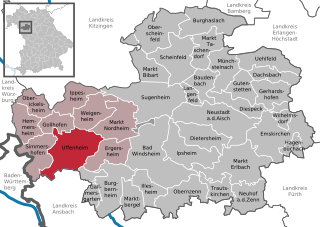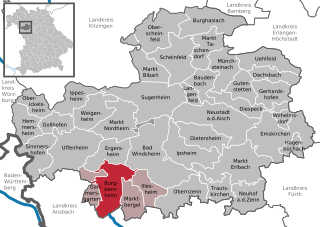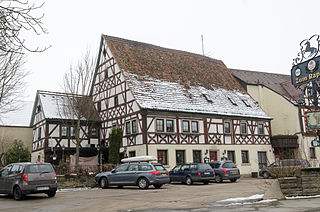Neustadt (Aisch)-Bad Windsheim is a Landkreis (district) in Bavaria, Germany. It is bounded by the districts of Würzburg, Kitzingen, Bamberg, Erlangen-Höchstadt, Fürth and Ansbach, and by the state of Baden-Württemberg.

Grafenwöhr is a town in the district of Neustadt an der Waldnaab, in the region of the Upper Palatinate in eastern Bavaria, Germany. It is widely known for the United States Army military installation and training area, called Grafenwoehr Training Area, located directly south and west of the town.

Neustadt an der Aisch is a small town of around 13,000 inhabitants in the northern part of Bavaria (Germany), within the Franconian administrative region Middle Franconia. It is the district town of the district Neustadt (Aisch)-Bad Windsheim.

Bad Wörishofen is a spa town in the district of Unterallgäu in Bavaria, Germany, known for the water-cure (hydrotherapy) developed by Sebastian Kneipp (1821–1897), a Catholic priest who lived there for 42 years. Many of the resort hotels and boarding-houses in Bad Wörishofen offer their guests treatment using Kneipp's methods.

Bad Brückenau is a spa town in Bad Kissingen district in northwestern Bavaria in the Rhön Mountains.

Bad Wiessee is a municipality in the district of Miesbach in Upper Bavaria in Germany. Since 1922, it has been a spa town and located on the western shore of the Tegernsee Lake. It had a population of around 4800 inhabitants in 2014. The word "Bad" means "spa" or "baths", while "Wiessee" derives from "Westsee", meaning "western part of the lake". Bad Wiessee was first documented in 1017 in the tax book of the Tegernsee Abbey, encouraged to pay goods to the abbey.

Uffenheim is a city in the Middle Franconian district of Neustadt (Aisch)-Bad Windsheim, in Bavaria, Germany. It is situated 14 km west of Bad Windsheim, and 36 km southeast of Würzburg.

Bad Berneck im Fichtelgebirge is a spa town in the district of Bayreuth, in Bavaria, Germany. It is situated on the White Main river, in the Fichtel Mountains, 13 km northeast of Bayreuth. It lies in the northern part of the Bavarian province of Upper Franconia. Since 1857 it has been a spa, initially based on its climate and whey products. In 1930 it became a Kneipp spa and, in 1950, a Kneipp health spa.

Burgbernheim is a town in the Neustadt (Aisch)-Bad Windsheim district, in Bavaria, Germany. It is situated 9 km (6 mi) southwest of Bad Windsheim, and 13 km (8 mi) northeast of Rothenburg ob der Tauber. It has a population of around 3,300.

Scheinfeld is a town in the Neustadt (Aisch)-Bad Windsheim district, in Bavaria, Germany. It is situated 14 km northwest of Neustadt (Aisch), and 40 km east of Würzburg. Schloss Schwarzenberg is adjacent to the town. The town is home to an Adidas testing factory.

Ergersheim is a municipality in Bavaria, Germany.

Bad Bocklet is a municipality in the district of Bad Kissingen in Bavaria in Germany. It is a market town and a health spa.

Markt Einersheim is a market town and municipality in the district of Kitzingen in Bavaria, Germany. On April 5, 1945, at the end of World War II, the town was bombed by United States Army Air Forces P-47 Thunderbolts. American troops captured the town from German forces, who retreated to the southeast, on April 6.

Gollhofen is a municipality in the district of Neustadt (Aisch)-Bad Windsheim in Bavaria in Germany.

Illesheim, founded 1283 AD, is a municipality in the district of Neustadt (Aisch)-Bad Windsheim in Bavaria in Germany. The earliest leader affiliated with Illesheim's foundation was Götz von Berlichingen, known as "the Knight with the Iron Hand." Also known locally as "Illesa". It lies 6 kilometers west of Bad Windsheim and 11 kilometers east of the A7 motorway.

Markt Bibart is a market town and municipality in the district of Neustadt (Aisch)-Bad Windsheim in Bavaria in Germany.

Oberickelsheim is a municipality in the district of Neustadt (Aisch)-Bad Windsheim in Bavaria in Germany.

Oberscheinfeld is a municipality in the district of Neustadt (Aisch)-Bad Windsheim in Bavaria in Germany.

Giebelstadt is a municipality in the district of Würzburg in Bavaria in Germany.

The Bavarian State Archaeological Collection in Munich is the central museum of prehistory of the State of Bavaria, considered to be one of the most important archaeological collections and cultural history museums in Germany.


























